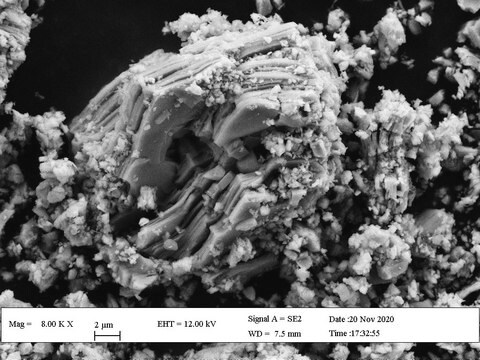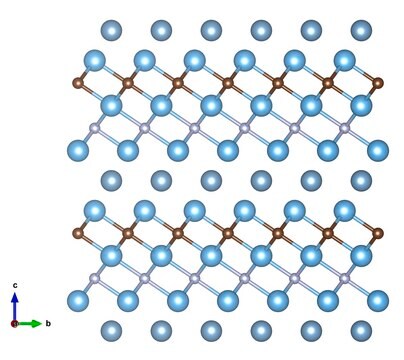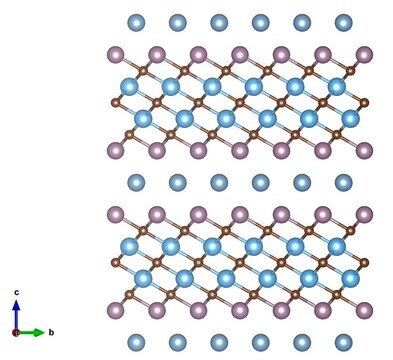910740
Titanium aluminium carbide 312
≥90%, ≤200 μm particle size
Synonyme(s) :
MAX Phase 312, Ti3AlC2
Se connecterpour consulter vos tarifs contractuels et ceux de votre entreprise/organisme
About This Item
Produits recommandés
Pureté
≥90%
Forme
powder
Couleur
dark gray
Taille des particules
≤200 μm
Vous recherchez des produits similaires ? Visite Guide de comparaison des produits
Application
MAX phases are a family of ternary carbides and nitrides that share a similar layered hexagonal crystal structure. They are so called because of their chemical formula: M(n+1)AXn —where n = 1, 2, or 3, where M is an early transition metal, A is an element from the IIIA or IVA groups, and X is carbon and/or nitrogen class of materials. MAX phases combine attractive properties of both ceramics and metals, and has been suggested for potential applications in nuclear reactor. The specific activities of Ti3AlC2 and Ti2AlC were found to be similar to SiC, and are three orders of magnitude less than Alloy 617 after 10–60 years decay for all three activation times in both the fast and thermal spectra.
MAX phases are important precursors for synthesizing MXene, a highly conductive 2-dimentional nanomaterial. MXenes are produced by selective etching of the A element from the MAX phases. It combine the metallic conductivity of transition metal carbides with the hydrophilic nature of their hydroxyl or oxygen terminated surfaces. Ti3AlC2 MAX phase is one of the most used MAX phase for MXene (Ti3C2Tx).
MAX phases are important precursors for synthesizing MXene, a highly conductive 2-dimentional nanomaterial. MXenes are produced by selective etching of the A element from the MAX phases. It combine the metallic conductivity of transition metal carbides with the hydrophilic nature of their hydroxyl or oxygen terminated surfaces. Ti3AlC2 MAX phase is one of the most used MAX phase for MXene (Ti3C2Tx).
Autres remarques
Code de la classe de stockage
13 - Non Combustible Solids
Classe de danger pour l'eau (WGK)
WGK 3
Certificats d'analyse (COA)
Recherchez un Certificats d'analyse (COA) en saisissant le numéro de lot du produit. Les numéros de lot figurent sur l'étiquette du produit après les mots "Lot" ou "Batch".
Déjà en possession de ce produit ?
Retrouvez la documentation relative aux produits que vous avez récemment achetés dans la Bibliothèque de documents.
Guidelines for Synthesis and Processing of Two-Dimensional Titanium Carbide (Ti3C2Tx MXene)
Alhabeb M, et al.
Chemistry of Materials, 29(18), 7633-7644 (2017)
Notre équipe de scientifiques dispose d'une expérience dans tous les secteurs de la recherche, notamment en sciences de la vie, science des matériaux, synthèse chimique, chromatographie, analyse et dans de nombreux autres domaines..
Contacter notre Service technique






